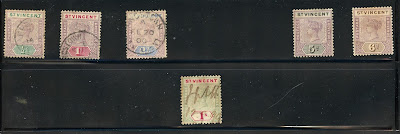I’ll comment on the stamps of Zambezia (1894-1920) and
its two districts – Quelimane and Tete – in a single post. Scans for all three
are shown below. They’re straight forward Portuguese colonial stamps, but not
well understood philatelically. At the turn of the 20th century,
social turmoil in the Mozambique part of Portugal’s empire makes anything said
about its philately highly conjectural.
If you like research and are willing to risk not
coming up with much, then the stamps of Zambezia, Quelimane and Tete might be
the topic on which to build an internationally acclaimed reputation. Be
forewarned, however, that existing literature is scant and often contradictory,
analytical history almost nonexistent, and official documents scarce and
inaccessible. A familiarity with the Portuguese language will help, though.
If you or anyone you know are interested in such a
venture, here’s what I’d like to know about these stamps:
· Why
and when exactly was Zambezia split into two districts, Quelimane and Tete? Current
philatelic literature posits three dates: 1902, 1907, and 1913. Or was it never
really a split?
· Was military action involved when the split occurred, perhaps in Tete?
· If
the earlier date is more accurate, why were Zambezia stamps continued in use
and Quelimane and Tete stamps not issued until 1913-14? And why were
overprinted Zambezia stamps issued in 1915?
Why was the Zambezia Company not a charter company that had control over postal
services, such as was the case with the Nyasa Company and Mozambique Company?
· In
what ways did the prazo system of land tenure in Zambezia affect postal
service? Through prazo, large feudal estates were controlled by
Portuguese traders and soldiers in the Zambesi River basin. Prazo-holders’
loyalty to the Portuguese crown was minimal and they operated independently sometimes
supported by their own armies.
· Apart
from the overprint “Republica” on the Vasco da Gama series, how did the coup
d’état in Portugal (5 October 1910) affect colonial postal services?
· Why
were the Vasco da Gama stamps recycled for use 20 years after they were first
issued? Do the recycled stamps differ from the originals in ways other than the
overprints? Was there a huge oversupply?
Why are Quelimane and Tete stamps usually found in mint condition while Zambezia’s are commonly in used condition? Were the former issued mainly for sales to collectors and not so much for local use?
· Why
are Quelimane and Tete stamps exact duplicates, except for the key plates and
overprints of the districts’ names? Inhambane has similar issues.
· Why
are covers from this area scarce and expensive? What can be learned from covers
that do exist?
· To
what extent were stamps of the various Mozambique districts used
interchangeably, say, Inhambane stamps cancelled at a Tete post office?
· How
scarce were stamps in Tete and Quelimane? Some covers exist that have only a
small fraction of a stamp on them.
Ambitious researchers need not start from scratch. Three
sources provide something of a head start: 1- Gerben van Gelder’s Stamps World
History site has discussions about the stamps of all Mozambique districts. See
for instance: https://stampworldhistory.com/country-profiles-2/africa/quelimane/.
2- See also relevant articles in the UK-based Portuguese Philatelic Society
Bulletin. 3- Writing in Portuguese, Luís Brito Frazão focuses on general
Portuguese philately and has a book titled Contribuição para a história
postal do Baixo Zambeze (2008) Contribution to the Postal History of the
Lower Zambezi.
A final caution: Portuguese officials sometimes grossly
overstate the quality of life in the African colonies. Franco Nogueira,
Portuguese Foreign Minister (1961-69), boasted: “We alone, before anyone else,
brought to Africa the notion of human rights and racial equality. We alone
practiced the principle of multi-racialism, which all now consider to be the
most perfect and daring expression of human brotherhood and sociological
progress…. Our African provinces are more developed, more progressive in every
respect than any recently independent territory in Africa south of the Sahara,
without exception.”(1) Nogueira uttered these falsehoods during the Mozambiquan
war for independence (1964-75) that cost one million lives, displace five
million citizens, and created nearly two million international refugees.
Census: Quelimane, 20 in BB spaces, 15 on supplement page. Tete, 21 in BB spaces, 19 on supplement page. Zambezia, 37 in BB spaces, 41 on supplement page.
(1) Cited
by Gerald J. Bender, Angola Under the Portuguese: The Myth and the Reality,
(1978) p xxi.
(2) Photo credit: Cgreenhaf. Accessed via https://en.m.wikipedia.org/wiki/File:Tete,_Mozambique.jpg. In public domain.









.jpg)



.jpg)



.jpg)
.jpg)
.jpg)























